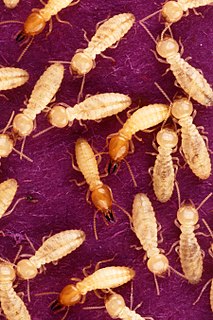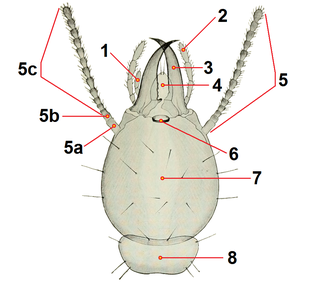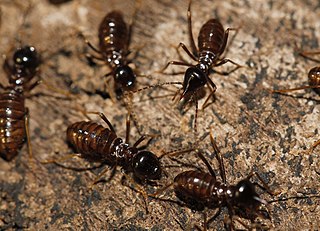
The Formosan termite is a species of termite that has been transported worldwide from its native range in southern China to Taiwan, Japan, South Africa, Sri Lanka, Hawaii, and the continental United States.

Coptotermes is a genus of termites in the family Rhinotermitidae. There are about seventy-one species, many of which are economically destructive pests. The genus is thought to have originated in southeastern Asia. Worker termites from this genus forage underground and move about in roofed tunnels that they build along the surface.
Neotermes greeni, is a species of drywood termite of the genus Neotermes. It is native to India and Sri Lanka. It closely resembles Postelectrotermes militaris. It is a minor pest of tea in Sri Lanka, and major pest of mango in India.
Glyptotermes ceylonicus, is a species of damp wood termite of the genus Glyptotermes. It is endemic to high elevations Sri Lanka. It is a pest of dead and decaying wood of Hevea, Theobroma, Ficus, and Acacia species.
Cryptotermes ceylonicus, is a species of dry wood termite of the genus Cryptotermes. It is found in Sri Lanka. It is found in living wood, and other man-made wooden constructions. They possess teeth-less mandibles.
The Indo-Malaysian drywood termite,, is a species of dry wood termite of the genus Cryptotermes. It is found in Philippines, Australia, Papua New Guinea, Hawaii, and introduced to Sri Lanka. It is the smallest termite species in Australia, with 2.5 – 3.7mm in soldiers.
The West Indian drywood termite,, is a species of dry wood termite of the genus Cryptotermes. It is native to Indonesia, Java and exotic to Australia, Trinidad and Tobago and Sri Lanka. It is predominantly a house termite found in natural and man-made wooden structures. Thus, this is the most commonest and most devastating drywood pest termite found in the world. It is a larger termite species, with 4.55-7.15mm length in soldiers.

Coptotermes ceylonicus, is a species of subterranean termite of the genus Coptotermes. It is native to India and Sri Lanka. It is a common wood destroying termites, which damage to logs, woodens structures of both natural and man-made. It is a pest of many economically valuable trees such as Hevea brasiliensis and Camellia sinensis, and also an inhabitant of Anacardium occidentale, Cocos nucifera, Ficus fergusonii, Gliricidia sepium, Grevillea robusta, Madhuca longifolia, Tamarindus indica and Theobroma cacao.
Coptotermes gaurii, is a species of subterranean termite of the genus Coptotermes. It is native to South India and Sri Lanka. It is a serious pest of tea in Sri Lanka.
Heterotermes indicola, is a species of subterranean termite of the genus Heterotermes. It is native to tropical India, Pakistan and Sri Lanka but has extended its range into the subtropics and warm temperate areas of the Himalayan foothills to altitudes of about 2,000 m (6,600 ft). It causes damage to timber in buildings and is one of the most destructive termites in urban and agricultural areas in the world. Soldiers are about 4.05-4.89mm long. Extracts of garlic and Calotropis procera are known to have Termiticidal effects on H. indicola.
Macrotermes convulsionarius, is a species of termite of the genus Macrotermes. It is native to India and Sri Lanka. Soldiers are very large with well developed mandibles. It is a major pest of many wood works in buildings. Flagellated bacteria such as Bacillus, Acinitobacter, Salmonella, Enterobacter, and Enterococcus are found abundant in gut of M. convulsionarius.
Odontotermes escherichi, is a small species of termite of the genus Odontotermes. It is native to India, Sri Lanka and Peninsular Malaysia. It attacks many dead, tree stems and decaying logs.
The Fungus-growing termite,, also known as South Asian wood-destroying termite, is a small species of earth dwelling termite of the genus Odontotermes. It is native to India and Sri Lanka.

Odontotermes horni, is a species of termite of the genus Odontotermes. It is native to India and Sri Lanka. It attacks many dead, decaying trees and fertilized soil. Though nests on ground, they do not construct a termitaria. It is a pest of tea, coconut and sugarcane.

Hospitalitermes monoceros, is a species of nasute termite of the genus Hospitalitermes. It was originally considered to be endemic to Sri Lanka, but was also found in India in 2013. It is an obligate lichen feeder. It is recorded from Cassia multijuga and Ficus religiosa trees and is a pest of tea.
The Snouted harvester termite,, is a species of mound building termite of the genus Trinervitermes. It is native to India and Sri Lanka. Type species was described from Bandarawela area of Sri Lanka. It is a pest of sugarcane, and brinjal.
Trinervitermes rubidus, is a species of mound building termite of the genus Trinervitermes. It is native to Sri Lanka.
Ceylonitermellus kotuae, is a species of termite of the genus Ceylonitermellus. It is endemic to Sri Lanka, first described from Kotuwa area of Galle. It is a soil-dwelling and soil-feeding termite species.
Acanthaspis quinquespinosa is a species of assassin bug found in India, Sri Lanka, Myanmar, Nepal and Tibet. It is a predator, and both nymphs and adults feed on termites, beetles, caterpillars and other insect prey.



